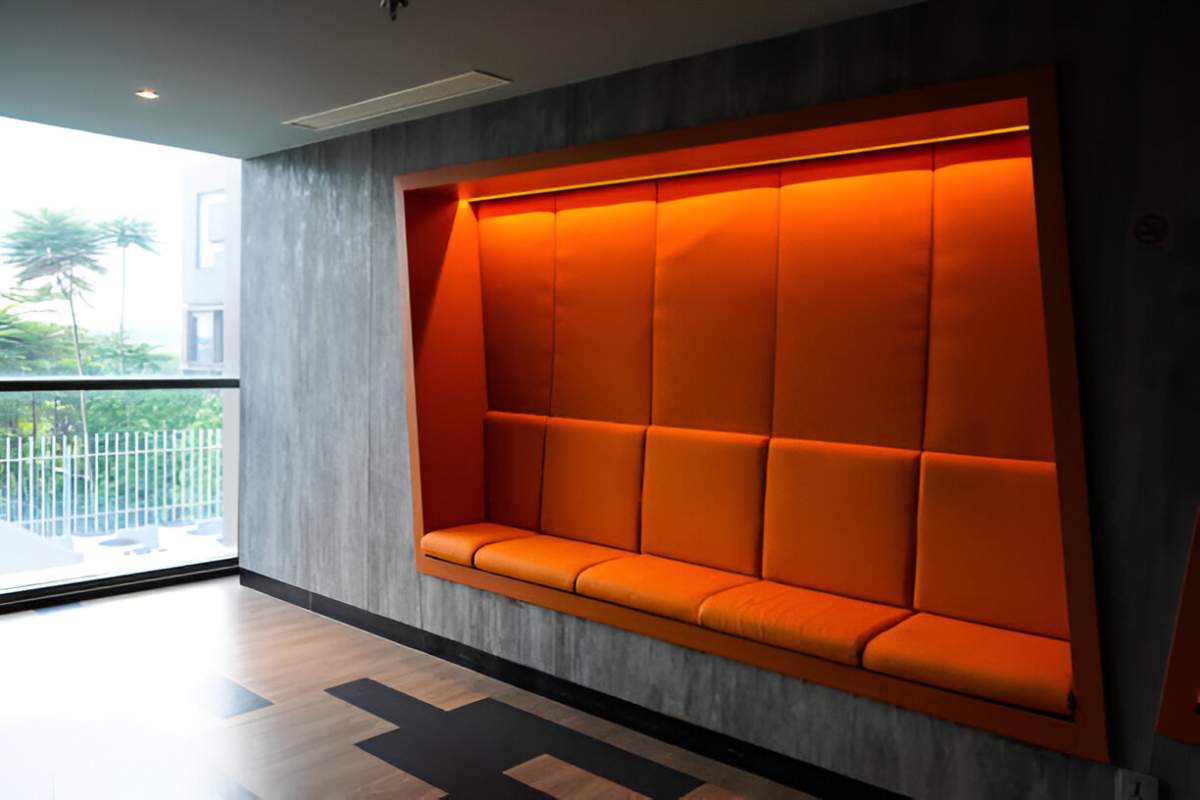A restaurant’s atmosphere extends much beyond its wonderful meals and attentive service. Today’s diners are increasingly looking for environments that are welcoming, comfortable, and well-designed. Semi-enclosed booths are popular because they provide a cozy, private atmosphere while yet allowing diners to take in the general ambiance of the restaurant. However, these booth locations provide distinct acoustic issues. Sound can become trapped, resulting in irritating echoes or noise that disrupts both comfort and communication.
This is where acoustic upholstery comes in as a quiet hero, absorbing unwanted noise while also providing visual interest to the dining experience. The appropriate material choices may transform restaurant booths into visually appealing and acoustically pleasing dining environments, eventually increasing customer satisfaction and encouraging positive feedback and future visits. This article investigates how acoustic upholstery materials balance sound control and aesthetics, offering clear advice for restaurant designers and owners seeking beautiful, comfortable, and sound-friendly interiors.
Acoustic Fundamentals Inside Semi-Enclosed Booths
Because of their enclosed structure, semi-enclosed booths frequently form miniature echo chambers without intention. This can increase both voices and ambient noise, resulting in a noisy atmosphere. Managing sound in these booths entails absorbing excess noise, dispersing sound waves, and restricting sound transmission. Acoustic performance is typically quantified using measures such as noise reduction coefficient (NRC), sound absorption average (SAA), and decibel (dB) reduction levels.
Designers must comprehend these parameters since clear speaking, privacy, and overall comfort have a direct impact on guests’ experiences. Understanding the normal frequency range of restaurant sounds aids in the selection of appropriate materials, ensuring that acoustic difficulties are successfully addressed. Background noise, such as music or chatter, might conceal some acoustic problems, but persistent faults, such as echoes or loud reverberations, become obvious and unpleasant.
Core Material Properties for Sound Control
Material selection for acoustic upholstery requires balancing numerous features, such as porosity, fiber diameter, and surface texture, all of which are important for absorbing mid-to-high frequency sounds. Surprisingly, heavier or thicker materials are not necessarily better; in small booth areas, lighter materials with strategically placed backing membranes or air gaps frequently function well. Healthy interior design considerations include fire resistance, minimal chemical emissions (low VOCs), and antibacterial elements.
Moisture control is critical because moisture affects both upholstery longevity and acoustic performance. Fabrics that successfully control heat can also influence perceived comfort levels, contributing gently to a peaceful dining experience. Additionally, selecting fabrics with appropriate light reflection qualities helps to preserve visual attractiveness and a sensation of brightness in enclosed rooms.
Traditional Fabrics vs. Technical Acoustic Textiles
Classic textiles such as velvet, wool, and chenille remain popular because they provide warmth, elegance, and a wide range of colors. Acoustic-specific textiles, such as microperforated synthetics or knit-backed composites, provide better sound control without adding bulk. These designed materials effectively attenuate sound and are usually easier to clean.
Texture and patterns can be intentionally chosen to conceal wear and extend aesthetic appeal. Acoustic fabrics may require a larger initial expenditure, but they often endure longer and provide superior acoustic results, making them economically sound. Color stability, resistance to sunlight fading, and tactile feel are all factors that influence material selection, adding richness to the sensory experience of the booth.
Foam, Batting, and Composite Backings
Behind every effective upholstery fabric lies careful cushioning design. Open-cell foam offers excellent sound absorption, particularly in mid-to-high frequencies, while closed-cell foam helps control vibrations and structure-borne noise. Combining foams with layers like mass-loaded vinyl creates advanced acoustic control. Environmentally friendly materials like recycled polyester batting maintain performance under heavy restaurant use. Moisture barriers and breathable linings help cushions stay fresh, dry, and acoustically effective over time. Durability tests that simulate repeated seating cycles can predict how upholstery will perform in busy restaurants, while techniques like edge-hardening and cushion replacements ensure booths maintain their acoustic and visual integrity.
Aesthetic Integration Without Compromise
Acoustic performance should never be at the expense of aesthetics. Colors have a significant impact on restaurant booth mood, with warmer tones generating intimacy and brighter hues creating a lively atmosphere. A careful choice of pattern sizes keeps booths from feeling crowded. Stitching techniques like quilting and channeling add visual appeal while also enhancing sound absorption. Additional design elements, such as piping, tufting, or logo trims, add style without interfering with acoustics. Incorporating minimal LED lighting and matching colors with other interior features creates a seamless look, while digitally printed acoustic materials allow for personalized branding on booth surfaces.
Cost-Performance Optimization
Balancing cost and acoustic effectiveness involves smart budgeting. Selecting upholstery from good, better, and best tiers helps align design goals with financial realities. Combining orders, such as buying upholstery and booth structures together, lowers overall costs. Real-world ROI metrics show that improving acoustics often increases customer satisfaction and turnover rates, quickly offsetting initial investments. Partial acoustic solutions or phased implementations offer affordable entry points, allowing venues to upgrade acoustics gradually. Negotiating volume discounts or purchasing directly from manufacturers further maximizes budget efficiency.
Acoustic Testing & Measurement On-Site
Practical acoustic assessments ensure booths meet expectations. Simple tests, such as clapping hands or smartphone apps, provide quick assessments. Portable measurement tools allow testing before full-scale installations. Once booths are installed, regular acoustic checks using customer feedback surveys and simple sound-level monitors (just like employee monitoring software) ensure continued comfort. Documenting results helps businesses clearly see the value of acoustic improvements, especially when seeking certification for health-focused programs like WELL or LEED.
Installation Best Practices & Error Avoidance
Proper installation techniques improve acoustic benefits. Installing upholstery after ceilings and floors results in a comprehensive acoustic solution. Uniform air gaps behind the seat panels ensure constant acoustic performance. Choosing between prefabricated and on-site cut panels requires balancing precision, ease, and aesthetics. Staff training in correct maintenance helps to retain acoustic performance. Mock-ups and early trials help to avoid costly mistakes during full installations, and precise procedures for handling adhesives, fasteners, and fire retardants ensure a safe and successful installation.
Harmonizing Sound and Style: The Takeaway
Harmonizing sound control and visual appeal in semi-enclosed restaurant booths is more than just an optional extra; it’s critical for generating memorable dining experiences. Acoustic upholstery materials that are carefully selected can have a significant impact on client comfort, contentment, and overall ambiance. Restaurants may create attractive, practical rooms that make customers feel relaxed and want to return by taking into account key acoustic features as well as aesthetic qualities.
Investing in high-quality, acoustic-optimized upholstery pays off not just in terms of reduced noise and improved beauty, but also in customer loyalty, favorable feedback, and increased business success. Embracing acoustic design as a core component of interior design equips restaurants to thrive in a competitive sector, delighting guests with balanced sensory experiences that seamlessly combine sound and elegance.











Leave a Comment